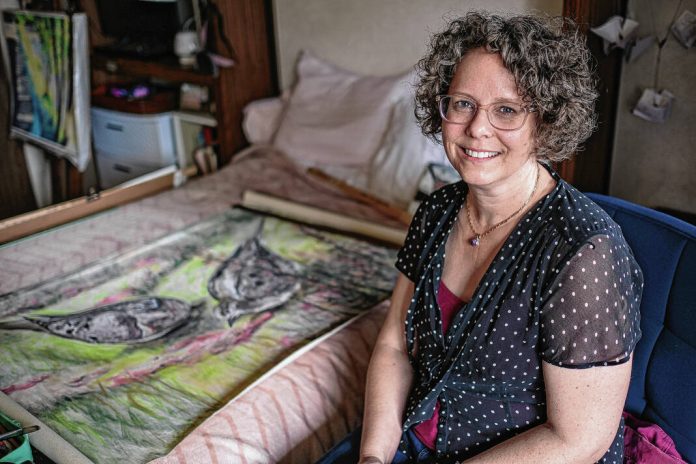
Mike Wolanin | The Republic Local artist Kimberly Free poses for a portrait in her studio apartment in Columbus, Ind., Tuesday, May 2, 2023.
For all of Kimberly Free’s flowing artistic giftedness, she draws and paints perhaps the most detailed picture of severe mental illness and chronic pain. Plus, she frames that talk of major depressive disorder and fibromyalgia with a forthrightness that is both disarming and enlightening.
The 45-year-old Columbus native and former arts administrator is willing to speak of her life simply to highlight her first solo gallery art show ever, “Outside: Works On Paper.” It opens with a free public reception at 5 p.m. Friday at Lost Dog Gallery, 1040 E. New York St. in Indianapolis. The exhibition runs through June 30.
The “outside”reference seems fitting on multiple levels simultaneously: one, because she is stepping outside her normal comfort zone and two, because she is reaching outside the bounds of general, everyday conversation to speak of what sometimes is pushed to society’s margins.
“This show is valuable because it exists,” she said from her intimate, studio-sized apartment on Cardinal Court in Columbus. “Recovery from chronic mental and physical pain means daily acts of faith in oneself and one’s future. With the support of family, friends, providers, support groups, and a higher power, I create a contented and meaningful life.”
The American Psychiatric Association reports that chronic pain and mental health disorders often occur together. Free calls her art that she has created since 2016 “my daily anchor.”
Not always for money
She recently warmly met visitors to her space by greeting them on the walkway like a polished hostess. Yet, she acknowledged that few people know of her work, with this exhibit featuring some 25 unframed landscapes, wildlife and the like depicted in colored charcoal brushed over with water and sealed with a spray. They are for sale, plus added 2-inch by 3-inch pieces for free.
“Art doesn’t always have to be for money,” she said. “I guess I’m kind of a weirdo.”
She laughed easily at herself. A few weeks ago, her scenes of everything from doves to daffodils were spread on her bed, the floor — anywhere she could find space while she searched for the emotional space to define herself.
“Sometimes I just clip things to the fence out there because the light is normally so good,” she said cheerily.
On this day, the natural light streaming into her small bedroom belied the dark times she has seen with severe depression and excruciating back pain that often leaves her exhausted, misunderstood and in a transfer chair for physical support.
“Now that I more fully understand that my eccentricity and my intensity is the artist part of me, all of the sudden, it’s not an illness, but just simply me,” she said. “I guess I could have basically checked in (to some facility) somewhere before and thought of myself as completely done.”
She cannot easily decipher her darkness. She lives frugally on disability assistance. Even with prescription medicine, she faces days when merely getting dressed to venture out is a challenge.
“Clinical depression has a voice all its own,” she said.
Her Zen practice helps, as does a form of specialized physical therapy called feldenkrais, known in part for boosting even one’s psychological state. In 2016, she was suicidal and treated for six weeks at a Chicago area residential facility.
Accepting misunderstanding
She accepts not only her condition but the fact that many people look at her occassionally in public and “think that I should be getting better,” as she put it.
“I just allow people not to understand,” she said.
Such is especially true when people sometimes see her conversing happily with others, or exercising her quick and exuberant wit to make a serious point with laughter.
“Does that confuse people?” she asked. “I always tell people: Those (good) feelings definitely do not last past 24 hours.
“But I know that people can think the mental and physical pain that I feel is phony.”
This can be even in spite of her medical records: back surgery in 2014 and extensive mental health help.
The water that she uses in these art pieces “fix” the colors in place just before they are covered with a sealing spray. In her life beyond art, there are no easy fixes.
Her past in mental health treatment includes electroconvulsive therapy, a type of forced seizure that has left her with amnesia. But she remembers some things crisply and sharply, including her delight in exhibiting in a space called Lost Dog Gallery.
“I certainly identify as a lost dog,” she said.
Others such as Brooke Hawkins, the executive director of the Columbus Area Arts Council where Free once worked, see her differently.
“Kim’s art beautifully captures moments of nature and life,” Hawkins said. “She often integrates geometric elements into her work, allowing it to feel peaceful and exciting.
“(And) Kim inspires our community with her candid dialogue about utilizing art as a transformative tool in coping with chronic mental and physical pain.”
Free’s aims are precisely that — and that people can be inspired in some way by her view of nature and the general outdoors “and its ephemeral, therefore valuable quality.”
Her works will hang unframed, reflective partly of the temporary state of most of life and her own vulnerability.
“And that’s OK,” she said. “Because everything changes.”
In Free’s campaign of art and mental and physical health awareness, she hopes that change includes one thing especially: people’s hearts.
About the exhibit
Who: Columbus native Kimberly Free
Exhibit: “Outside: Works on Paper” through June 30 at Lost Dog Gallery, 1040 E. New York St. in Indianapolis
Free opening reception: 5 to 8 p.m. Friday
Visit by appointment: Contact Free about the exhibit at [email protected]




